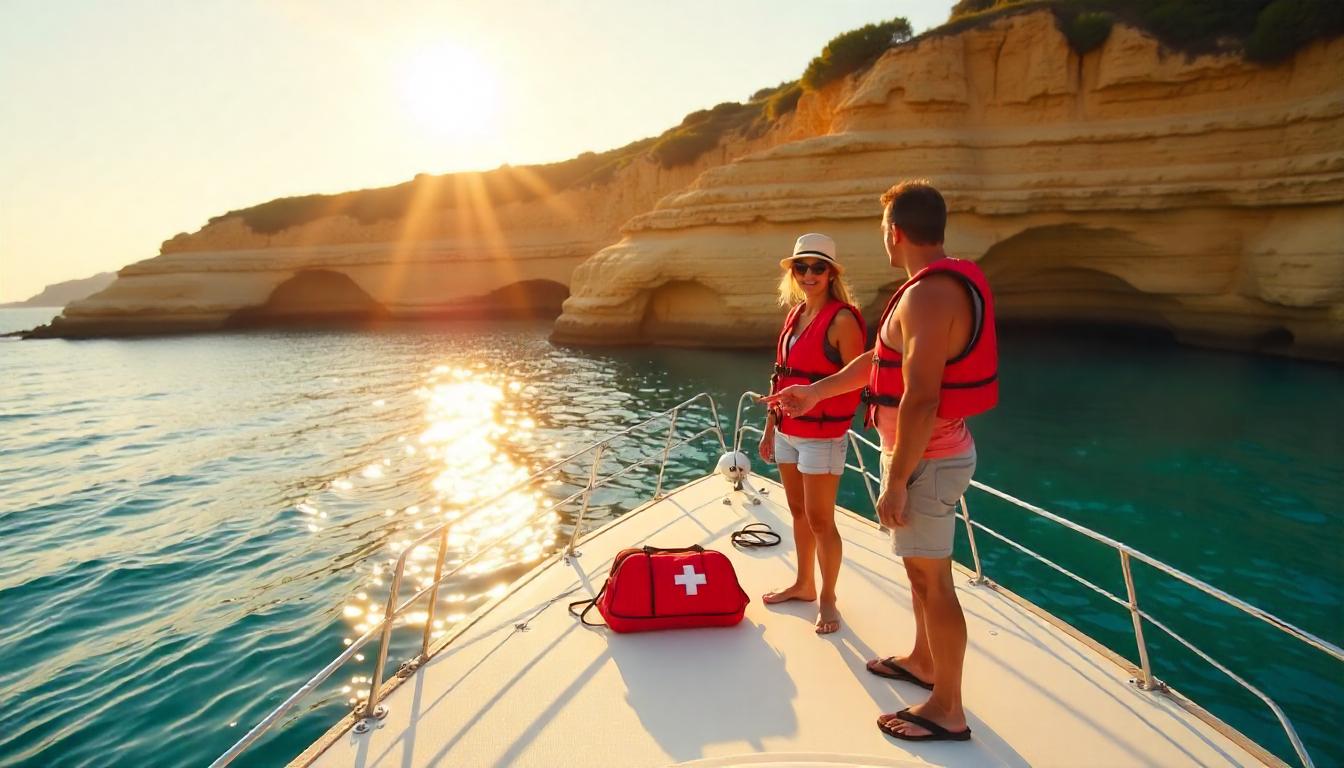Portugal’s 1,794 km coastline, stretching from the sun-drenched Algarve to the remote Azores, offers breathtaking yachting opportunities, but yachting safety Portugal remains a top priority for sailors navigating these diverse waters in 2025. With varied conditions—from the calm Tagus River in Lisbon to the unpredictable Atlantic swells near Nazaré—sailors must be prepared for challenges like sudden winds, rocky seabeds, and tidal changes. In this guide, we’ll explore essential yachting safety Portugal tips, ensuring a secure and enjoyable sailing experience along this stunning coast.
Why Prioritize Yachting Safety Portugal?
Prioritizing yachting safety Portugal is crucial due to the country’s diverse marine environments and weather patterns. For starters, Portugal’s mainland coast experiences the Nortada wind in summer, reaching 15 knots, while the Azores can see sudden squalls with winds up to 25 knots year-round. Moreover, rocky areas like Ponta da Piedade in the Algarve require careful navigation to avoid grounding. Consequently, understanding safety measures protects both your crew and your yacht, ensuring a smooth journey across Portugal’s waters.
Understanding Portugal’s Marine Conditions
Portugal’s marine conditions vary by region. For instance, the Algarve in summer has calm seas with 5-10 knot winds and 24°C water temperatures, ideal for beginners. In contrast, the west coast near Nazaré in winter can see 20-meter waves and 30-knot winds, demanding advanced skills. Transitioning to the islands, Madeira’s southern coast offers sheltered anchorages like Porto Moniz, but the Azores’ volcanic seabeds, such as around Ilhéu de Vila Franca, require precise anchoring. Thus, knowing these conditions is the first step in ensuring yachting safety Portugal.
Weather Monitoring for Yachting Safety Portugal
Weather monitoring is a cornerstone of yachting safety Portugal, given the country’s variable climate. For example, summer in Lisbon brings stable weather with 27°C temperatures and 5-15 knot winds, but sudden Nortada gusts can surprise sailors along the west coast. Additionally, the Azores in spring can see 100 mm of monthly rainfall, with squalls developing quickly. Transitioning to tools, apps like Windy, which are free, provide real-time wind and wave forecasts, helping you plan your route. Also, check local marine forecasts—Portuguese Institute for the Sea and Atmosphere (IPMA) updates, available online for free, are reliable. Therefore, staying informed about weather ensures safer sailing.
Preparing for Sudden Weather Changes
Sudden weather changes require preparation. For instance, always have a backup anchorage—Praia da Marinha in the Algarve offers shelter from westerly winds, a 5-minute sail from open water. Next, pack waterproof gear—summer showers in Madeira can be unexpected, and a good jacket costs $30, keeping you dry on deck. Transitioning to communication, ensure your VHF radio, costing $100, is functional to receive weather alerts from local marinas like Marina de Lagos. Moreover, sail in the morning—afternoon winds in Cascais can rise to 15 knots, making navigation trickier. Thus, preparation mitigates risks from sudden weather shifts.
Navigation and Equipment for Yachting Safety Portugal
Proper navigation and equipment are vital for yachting safety Portugal, especially in areas with hazards like rocky coastlines and strong currents. For example, the Tagus River in Lisbon has currents up to 2 knots during tidal changes, requiring careful timing—check tide schedules on apps like Tides Near Me, which are free. Additionally, the Berlengas Islands near Peniche have shallow reefs, so a depth sounder, costing $100, helps avoid grounding. Also, ensure your GPS is updated—systems like Garmin, costing $200, provide accurate charts for Portugal’s coast. Consequently, reliable navigation tools keep you safe on the water.
Essential Safety Equipment Checklist
Having the right equipment enhances safety. For instance, life jackets are mandatory—ensure each crew member has one, costing $30 each, and check they’re in good condition before departure. Next, carry a first aid kit—basic kits cost $20 and cover minor injuries like cuts from handling ropes. Transitioning to emergencies, a life raft, costing $500, is essential for long passages, especially in the Azores where help may be hours away. Also, pack an anchor light—required by law at night, costing $20, to ensure visibility in busy anchorages like Cacilhas near Lisbon. Therefore, a well-equipped yacht ensures preparedness for any situation.

Anchoring Safely in Yachting Safety Portugal
Anchoring safely is a key aspect of yachting safety Portugal, given the diverse seabeds along the coast. For example, Praia da Marinha in the Algarve has a sandy seabed with 3-5 meter depths, ideal for secure anchoring, but volcanic areas in the Azores, like Ilhéu de Vila Franca, have uneven rocky bottoms, requiring careful depth checks. Additionally, tidal shifts in the Tagus near Lisbon can move your yacht—use a second anchor, costing $50, for added stability. Transitioning to technique, drop anchor slowly to ensure it sets properly, and use a 5:1 scope ratio for strong holding. Thus, proper anchoring techniques prevent drifting and grounding.
Avoiding Anchoring Hazards
Avoiding anchoring hazards requires vigilance. For instance, check for underwater obstacles—apps like Navionics, costing $50 per year, show seabed charts for areas like Ponta da Piedade, where rocks are common. Also, monitor swing room—crowded anchorages like Praia Dona Ana in Lagos during summer can have 15 yachts, so ensure enough space to avoid collisions. Transitioning to weather, anchor during slack tide in the Tagus to prevent dragging—tide schedules are available for free online. Moreover, use a depth sounder to confirm depths in volcanic areas like São Jorge, ensuring your anchor holds. Therefore, these steps minimize anchoring risks.
Crew Safety and Training for Yachting Safety Portugal
Crew safety and training are essential for yachting safety Portugal, ensuring everyone onboard is prepared for emergencies. For example, conduct a safety briefing before departure—explain life jacket use, emergency exits, and radio operation, which takes 15 minutes and costs nothing. Additionally, ensure at least one crew member has basic first aid training—online courses from Red Cross cost $25 and cover CPR and wound care. Transitioning to communication, establish hand signals for non-verbal cues during high winds, like in Nazaré where winter gusts reach 30 knots. Also, practice man-overboard drills—use a fender as a dummy to simulate rescue, a free exercise. Thus, a trained crew enhances overall safety.
Handling Emergencies at Sea
Handling emergencies at sea requires readiness. For instance, if someone falls overboard near Cascais, throw a life ring, costing $20, and mark the spot on your GPS to circle back. Next, in case of a fire—common with galley mishaps—use a fire extinguisher, costing $30, and ensure it’s checked annually. Transitioning to medical emergencies, a first aid kit can treat minor injuries, but for serious issues like a broken arm in the Azores, contact the Portuguese Coast Guard via VHF Channel 16 for assistance. Moreover, carry an EPIRB—devices cost $300 and signal your location to rescuers. Therefore, preparedness ensures quick responses to emergencies.
Local Regulations in Yachting Safety Portugal
Understanding local regulations is a key part of yachting safety Portugal, as compliance prevents fines and ensures safety. For example, Portugal requires all yachts to have a valid registration—fines for non-compliance start at $200, so ensure your documents are updated before sailing. Additionally, speed limits apply in marinas—Marina de Lisboa enforces a 3-knot limit, and violations can cost $100. Transitioning to environmental rules, the Ria Formosa lagoon prohibits anchoring in seagrass areas to protect ecosystems—fines are $150, so use designated spots like Ilha Deserta. Also, fishing licenses are required for catching fish like sea bream—permits cost $10 per day. Thus, following regulations keeps your trip legal and safe.
Interacting with Local Authorities
Interacting with local authorities can ensure compliance. For instance, check in with the maritime police when arriving in Ponta Delgada, Azores—present your yacht’s registration and crew list, a free process that takes 10 minutes. Also, report any incidents—like a minor collision in Lagos—to the port captain, avoiding fines up to $500 for non-reporting. Transitioning to assistance, the Portuguese Coast Guard offers free safety inspections in Lisbon—schedule one to ensure your yacht meets standards. Moreover, carry a local contact—marinas like Marina de Cascais provide emergency numbers for quick help. Therefore, good relations with authorities enhance your safety.
Practical Tips for Yachting Safety Portugal
A few practical tips can enhance yachting safety Portugal across all regions. First, always have a float plan—share your route with a contact onshore, detailing stops like Nazaré and expected return dates, a free precaution. Next, pack extra provisions—unexpected delays in the Azores due to weather can extend your trip, and extra food for three days costs $50 for four people. Also, maintain your yacht—check the engine and sails before departure, as repairs in Madeira can cost $150 for minor fixes. Transitioning to navigation, sail during daylight—visibility in the Berlengas Islands drops at night, increasing risks. Thus, these tips ensure a safer yachting experience.
Safety Resources and Contacts
Safety resources can provide support. For example, the Portuguese Coast Guard’s emergency number, +351 214 401 919, connects you to help anywhere along the coast. Also, apps like SafeSkipper, costing $10, offer safety checklists for pre-departure checks in Portugal. Transitioning to local knowledge, marina staff in Lagos can advise on safe anchorages like Praia Dona Ana, a free service. Moreover, the IPMA website provides free marine weather updates, crucial for planning routes in the Azores. Therefore, leveraging these resources enhances your safety on the water.
Why Focus on Yachting Safety Portugal?
Focusing on yachting safety Portugal ensures a secure and enjoyable sailing experience, allowing you to fully appreciate the country’s stunning coast, from the Algarve’s turquoise waters to Madeira’s dramatic cliffs. By preparing for weather changes, equipping your yacht, and following local rules, you minimize risks and maximize enjoyment. Whether you’re sailing the Tagus or exploring the Azores, safety is key. For a secure yachting adventure, this is the way. Therefore, yachting safety Portugal is a sailor’s priority.
A Safe Yachting Journey in Portugal
Every safety measure enhances your journey. For instance, monitoring weather in the Algarve prevents surprises from the Nortada wind. Or, practicing emergency drills in Lisbon ensures your crew is ready for the unexpected. This preparation creates a worry-free trip. Thus, yachting safety Portugal leads to an adventure you’ll cherish.
Final Thoughts on Yachting Safety Portugal
Yachting safety Portugal lets you explore Portugal’s waters with confidence, from calm lagoons to challenging swells, with every precaution ensuring a smooth journey. By staying informed, equipping your yacht, and training your crew, you’ll create a sailing trip that’s both safe and unforgettable. So, prepare thoroughly, sail wisely, and let Portugal’s coast captivate you—one wave at a time.


